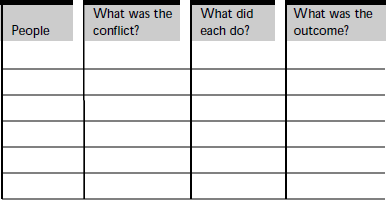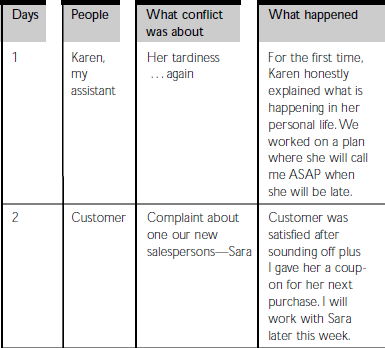Part of your success in dealing with conflicts involves taking some time to review the kinds of conflicts you have, when you have them, and with whom.
This honest evaluation is worth the effort because, in many cases, you will be able to take What you learned and avoid new conflicts in the future. For instance, you might find that you have a lot of conflicts at the same time of the day or notice you have more conflicts when you are tired. Knowing this, you can lay plans to organize your day around your energy levels.
Identifying your conflicts leads to quicker resolutions. The phrase To name it is to claim it means that once a conflict is named, a solution can be claimed. Named conflicts are no longer elusive, but instead manageable.
For instance, you might find that you keep having conflicts with the same person and nothing has changed. This is your red flag that it is time to get these conflicts out in the open with this person and work out those chronic issues.
The following are two methods you can use to name your conflicts. Once you complete the naming process and see its value, look for opportunities to show your staff members these techniques.
The Conflict Chart
This method involves identifying the kinds of conflicts you have with particular people in your life, both at work and in your personal life.

Use the chart shown above to develop your Conflict Chart. Down the left side of a piece of paper, list the names of people you come in contact with during a typical week. List as many as you want. Examples of people at work might be:
• your boss
• secretary
• individuals who report to you
• colleague in another department
• vendors or suppliers
• clients
To the right of each name, briefly write the conflicts you have had with each person in the recent week. What was the conflict? (Obviously you do not need to complete every line in the event you did not experience a conflict with that person.)
In the next column describe what method(s) you used to resolve the conflict. For instance, you discussed the issues until each person had a better understanding, or you negotiated a solution, or you obtained more information, or you asked your boss to intervene.
In the last column to the right, describe the outcome. F or instance, you all felt relieved that the conflict was resolved, or you felt more energized for your work, or you are sleeping better. Perhaps the conflict was handled poorly and the outcomes included you felt angry still or the conflict remains.
Once you have completed the chart, you are ready to review the information, look for patterns, and decide how you can deal with conflicts differently. Turn to page 20 at the end of this chapter for some questions that will help with this clarification.
Jake is a manager in an insurance office. He wants to assess the kinds of conflicts he has and how well he handles them, so he completed the Conflict Chart for one week. Here is his chart.
Before we move on to evaluating Jake’s log, look over the second method you might use to name your conflicts.
For the Record
The second method for naming your conflicts involves keeping a log of your conflicts for two weeks.

For two weeks, you take time each day to record information about a conflict you had that day. Try to do this at the same time each day, for example, just before heading for home. Of course, if you had no conflicts some days, note this too!
In the People column, note with whom you had the conflict. In the next column, briefly write about the conflict you have had with this person. What was the conflict?
In the next column describe what method(s) you used to resolve the conflict. For instance, you discussed the issues until each person had a better understanding, or you negotiated a solution, or you obtained more information, or you asked your boss to intervene.
At the end of two weeks you will be ready to evaluate what you recorded.
Susan is the manager of a retail store. Here is Susan’s record of her conflicts for two weeks.

What Have You Observed?
Once you have completed the Conflict Chart or For the Record log, you are ready to review the information, look for patterns, and decide how you can deal with conflicts differently. Ask yourself these questions:
1. Do you predominately have conflicts with the same types of people and rarely with others?
2. What are the usual causes of the conflicts? (You may want to review Chapter 4 on causes of conflicts.)
3. What generally worked to resolve the conflicts? What didn’t? (Later you can re view resolution methods in Chapter 6.)
4. What did not work? Did you make the conflict worse by going overboard, losing your temper, or becoming defensive?
5. Were the outcomes very different or similar? Were they generally positive outcomes?
6. What conclusions can you draw from reviewing this information?
7. What will you do differently the next time you face a conflict?
Jake looked over his week and realized that:
• My temper was very short this whole week.
• I had conflicts with five people, all of whom are important to me.
• I think my unresolved conflict with my wife kept me in a bad mood and then I took it out on my receptionist and the contractor.
• I think I handled the customer’s legitimate complaint well and have kept it from happening again by providing additional training for John.
Susan reviewed her two weeks of conflicts and came to the following observations:
• I have conflicts with all kinds of people at work from my assistant, my salesperson, stockers, cashier, and others I depend on like my landlord and vendor.
• My conflicts are caused for many reasons: I sometimes have unclear and unstated expectations. Sara needs more training and closer supervision. However, our vendor has serious problems with his business practices.
• Some conflicts were easy to fix, like my conflict with Chris and our customer. Others took more time, like working with the stockers.
• The problems with the vendor’s late shipments will cost me more time and money if I have to go to the lawyer.
• Next time I am over stressed or overly tired, I will try to take care of my conflicts with the employees more calmly or defer them until a later or more appropriate time.
• Conflicts are certainly a natural part of this type of work. I seem to handle most of them fairly easily, but I have much more to learn.
Jake and Susan, like you, benefit from keeping track of their conflicts. The insights they gain will help them when they further analyze the causes of all of their conflicts.
The key to understanding your conflicts is to know what they are. Starting today use one of these methods to record your conflicts, who they are with, and how you handled them. With this information in hand, you will be able to review ways you react to conflicts, as described in the next chapter.




